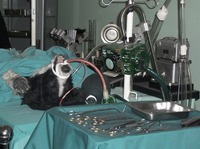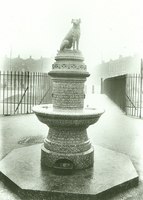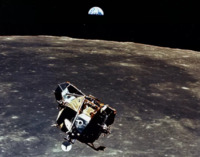Items
Site
The Medicine Chest
keywords is exactly
dog
-

Dogs in the Heart of Cape Town
The guided tour of the museum, which commemorates the first heart transplant performed by Chris Barnard in 1967, starts with a representation of the car accident that provided the heart for the transplant, through to the animal lab where Barnard conducted experiments with over 50 dogs to perfect the technique of heart transplantation. From there one can tour a model of Denise Darvall's bedroom and Christiaan Barnard's office before seeing a recreation of the surgery in the actual operating theaters where it occurred. -

The Brown Dog Affair (1903 - 1910)
On Feb. 2, 1903, English physicians William Bayliss and Ernest Starling, gave a lecture on the digestive system to a theatre full of medical students. Also in attendance were Lizzy Lind af Hageby and Leisa Schartau, committed feminists and anti-vivisectionists. They had travelled from Sweden to enrol at the London School of Medicine for Women, attend lectures around town, and document the practice of vivisection in British universities. During the lecture, a brown terrier was wheeled out, strapped to a board. Starling had already performed one experiment on the dog two months earlier, shutting off its pancreas. This time, Bayliss cut open the dog’s neck and spent half an hour unsuccessfully trying to stimulate the animal’s salivary glands with electrodes. Eventually, he gave up and handed the dog over to a student (Henry Dale, another future Nobel laureate) who stabbed it through the heart, thus ending the lesson. What followed was a court case filed by Stephen Coleridge, a prominent barrister and secretary of the National Anti-Vivisection Society against Bayliss. After four days of testimony, the judge called the women’s account “hysterical” while giving instructions to the jury. The jurors conferred for 20 minutes, then found Coleridge guilty of libel. Anti-vivisectionists commissioned a bronze statue of the dog as a memorial, unveiled in Battersea in 1906. Its plague, which read "Men and women of England, how long shall these Things be?" led to the it being vandalised on a frequent basis. On 10 December 1907, hundreds of medical students marched through central London waving effigies of the brown dog on sticks, clashing with suffragettes, trade unionists and 300 police officers, one of a series of battles known as the ‘Brown Dog’ riots. In March 1910, tired of the controversy, Battersea Council sent four workers accompanied by 120 police officers to remove the statue under cover of darkness, after which it was reportedly melted down by the council's blacksmith. -

Lithograph of underwater scene
Lithograph of underwater scene by Eugen Ransonnet-Villez, from colour pencil drawings made by the artist while submerged in his diving bell, from his 'Sketches of the Inhabitants, Animal Life and Vegetation in the Lowlands and High Mountains of Ceylon' (1867) -

Devils Bridge sketched by Lister
'Devils Bridge' sketched by Lister on his travels through Europe showing a bridge crossing the Gotthard Pass, northern approach, Switzerland. The term 'devil's bridge' is applied to many ancient bridges found primarily in Europe. These were stone or masonry arch bridges and, because they represented a significant technological achievement in ancient architecture, were objects of fascination and stories. The most popular of these featured the Devil, either as the builder of the bridge (relating to the precariousness or impossibility of such a bridge to last or exist in the first place) or as a pact-maker (sharing the necessary knowledge to build the bridge, usually in exchange for the communities souls). The legend attached to the bridge sketched by Lister is of the latter, and was related by Johann Jakob Scheuchzer in 1716. According to Scheuchzer, the people of Uri recruited the Devil for the difficult task of building the bridge. In return for his expertise, the Devil requested the soul of the first thing to pass the bridge. To trick the Devil, the people of Uri sent across a dog by throwing a piece of bread, and the dog was promptly torn to pieces by the Devil. Reference: Scheuchzer, J. , 1747 [1716]. Naturgeschichte des Schweitzerlandes. Vol. 2: 94. -

Four bruises
Poster designed by film director, Mike Mills. His 2010 movie, 'Beginners', is structured as a series of interconnected flashbacks. Following the death of his father, Hal, from cancer, Oliver reflects on their relationship during the last five years, since the death of his mother. -

Heart of Cape Town Museum
Christiaan Barnard did forty-eight trial transplants with dogs before he undertook such an operation with a human being. -

The Eagle has landed (Apollo 11 Lunar Module Ascent Stage Photographed from Command Module)
The Apollo 11 Lunar Module ascent stage, with Astronauts Neil A. Armstrong and Edwin E. Aldrin Jr. aboard, is photographed from the Command and Service Modules (CSM) during rendezvous in lunar orbit. The Lunar Module (LM) was making its docking approach to the CSM. Astronaut Michael Collins remained with the CSM in lunar orbit while the other two crewmen explored the lunar surface. The large, dark-colored area in the background is Smyth's Sea, centered at 85 degrees east longitude and 2 degrees south latitude on the lunar surface (nearside). This view looks west. The Earth rises above the lunar horizon. -

The Tacoma Narrows Bridge
The old Tacoma Narrows bridge was named Galloping Gertie because it vibrated rather strongly whenever there was a little wind due to resonance, the property which most objects have, of vibrating more strongly when exposed to an external force which is itself vibrating at the object's natural frequency. Crossing Gertie was actually quite a popular thing to do, similar to riding a roller-coaster. On November 7, 1940, things changed for the worse however. It was a day of rather high winds which caused Gertie to take on a 30-hertz transverse vibration with an amplitude of 1½ feet. This developed into a twisting motion of about 14 hertz, which then tore the bridge in two. The only victim of the disaster was a three-legged Cocker Spaniel, Tubby, left in the back seat of a lone car abandoned on the bridge.


